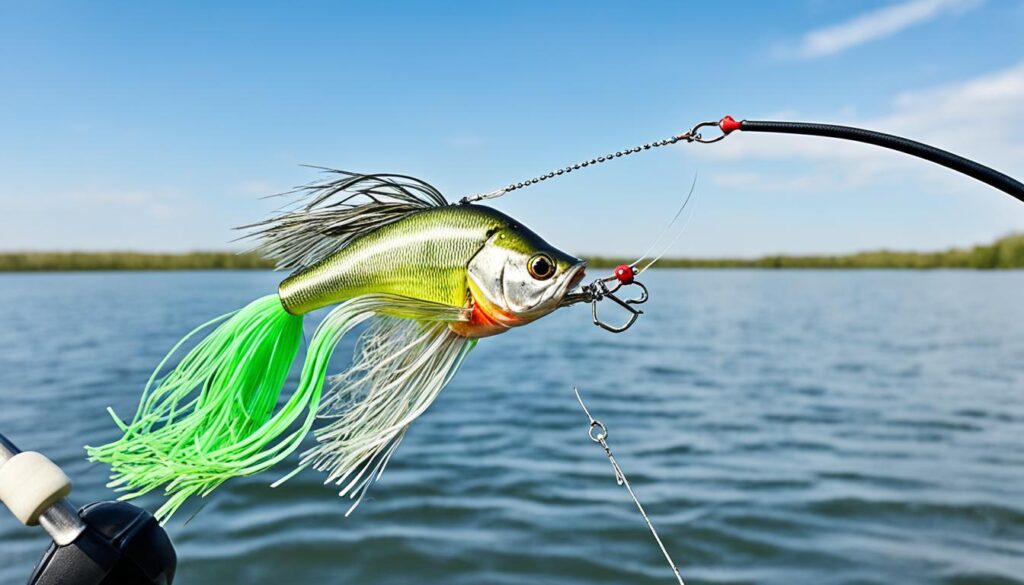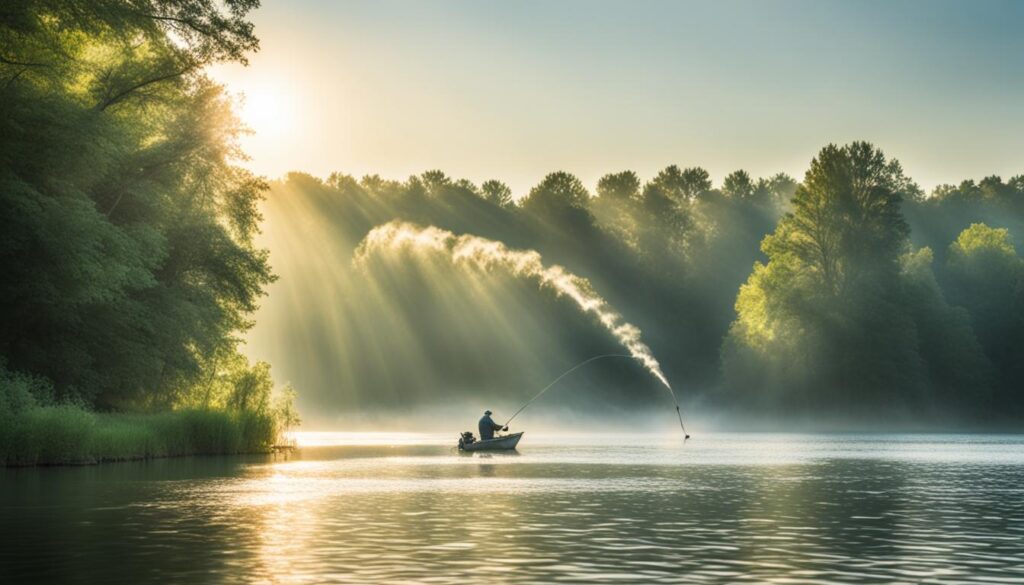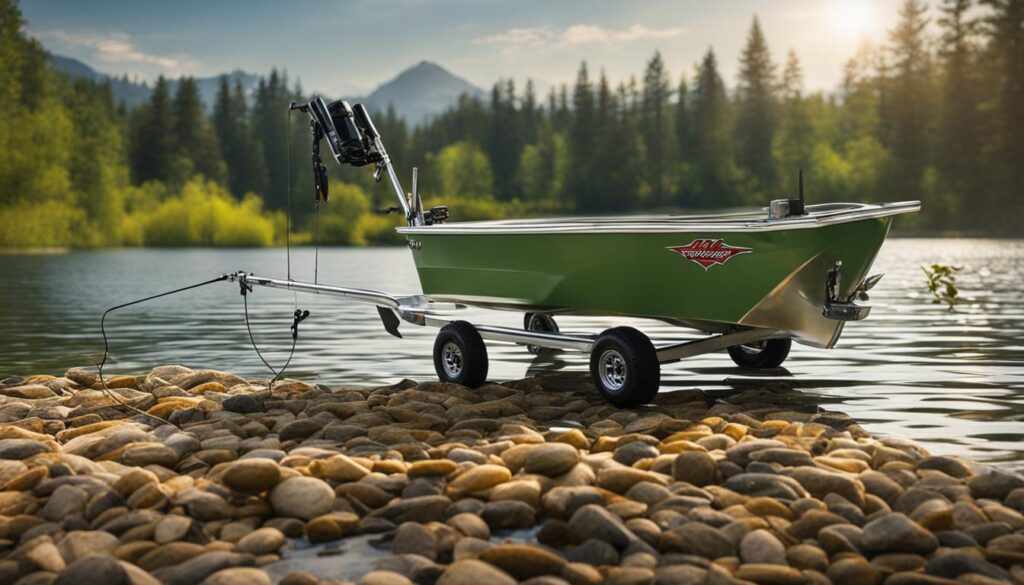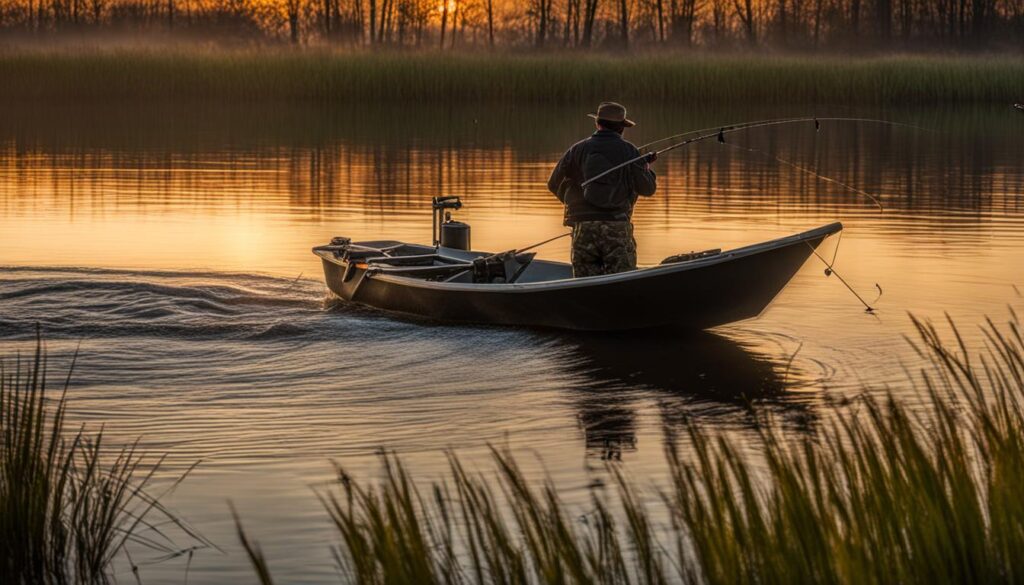As an avid angler, I know that early spring is the perfect time to start using buzzbaits for bass fishing. These lures have a unique ability to attract big fish even in colder water temperatures. In fact, many anglers have reported great success with buzzbaits during the early spring months, catching sizable bass in waters as cold as 50 degrees Fahrenheit.
So, why should you start throwing buzzbaits now? The answer lies in the behavior of the fish. During the early spring season, bass are starting to become more active as the water temperature gradually warms up. This means they are more willing to chase down and strike at fast-moving lures like buzzbaits.
When it comes to choosing the best buzzbaits for early spring, it’s important to consider several factors. One of the most crucial factors is the water temperature trend. If the water is consistently getting warmer, it’s a good indication that the fish are becoming more active and feeding. This is the perfect time to start throwing buzzbaits.
Location also plays a key role in selecting the right buzzbait. In early spring, bass can often be found in shallow areas or near cover, such as fallen trees or vegetation. Casting your buzzbait into these areas can increase your chances of attracting bites.
Finally, be mindful of the size of the baitfish that the bass are feeding on. Choosing a buzzbait that closely resembles the size and color of the baitfish can make it much more enticing for the bass to strike.
Key Takeaways:
- Early spring is a great time to start using buzzbaits for bass fishing.
- Buzzbaits can attract big fish even in colder water temperatures.
- Consider the water temperature trend, location of the fish, and baitfish size when choosing the right buzzbait for early spring fishing.
- Bass become more active as the water temperature warms up, making them more likely to strike at fast-moving lures like buzzbaits.
- Casting buzzbaits into shallow areas or near cover can increase your chances of attracting bites.
When to Throw Early Spring Buzzbaits
In early spring, knowing when to throw buzzbaits can significantly improve your chances of landing a big catch. The key factor to consider is the water temperature trend. As the temperature slowly starts to rise, the fish become more active and receptive to topwater lures like buzzbaits.
If the water temperature is on a warming trend and reaches around 50 degrees Fahrenheit, it’s time to start using buzzbaits. The bass are beginning to move shallower and are more likely to aggressively strike at these buzzing lures.
On the other hand, if the water temperature is consistently getting colder, it’s best to hold off on throwing buzzbaits, even if the temperature is around 57 degrees Fahrenheit. In colder water, the fish are usually less active and less likely to chase down a fast-moving buzzbait.
The key is to pay attention to the water temperature trend and ensure that the fish are actively feeding and warming up. This is when buzzbaits become an irresistible temptation for hungry bass.
Investing in a reliable water temperature gauge can be helpful in monitoring the temperature trend and determining the optimal time to throw buzzbaits. It’s also essential to observe the behavior of the fish in your local fishing spots and listen to the advice of experienced anglers in your area.
Now that we know when to throw buzzbaits in early spring, let’s explore some expert tips for fishing with buzzbaits during this exciting season.
Best Buzzbait Techniques for Early Spring Fishing

When it comes to early spring fishing, employing the right buzzbait techniques can make all the difference. Anglers have discovered various methods that yield impressive results, especially during this season. By implementing these techniques, you can maximize your chances of reeling in some hefty bass. Let’s dive into the top buzzbait techniques for early spring fishing.
1. Slow Retrieves for Surface Action
One highly effective technique favored by experienced anglers is the slow retrieve. This method involves allowing the buzzbait blade to stay on the surface for longer periods. By slowing down your retrieve, you give the bait more time to create enticing ripples and vibrations, attracting bass in the process. This technique can be particularly potent during the early spring months.
2. Opt for Subtle Buzzbaits
In early spring, using smaller buzzbaits with lighter blades can significantly increase your chances of enticing strikes. Opt for buzzbaits weighing around 1/4-ounce or 1/8-ounce for a more delicate presentation. These subtle buzzbaits mimic smaller baitfish and can prove irresistible to hungry bass cruising in shallower water.
3. Enhance Your Presentation with a Trailer
Adding a subtle trailer to your buzzbait can enhance its overall presentation and appeal. Consider attaching a YUM Bad Mamma trailer, known for its natural movement and lifelike appearance. This combination of a buzzbait and trailer creates a more substantial profile, increasing the chances of fish zeroing in on your bait and striking.
Utilizing these top buzzbait techniques for early spring fishing will give you an edge when targeting bass during this exciting season.
| Benefits of the Technique | Technique | Recommended Conditions |
|---|---|---|
| Creates enticing surface ripples and vibrations | Slow retrieves | When fish are in a more active feeding mode |
| Targets bass in shallower water | Subtle buzzbaits | Smaller baitfish present in the area |
| Provides a larger, more realistic bait profile | Buzzbait with a trailer | When fish are more selective or the water is murky |
Factors to Consider When Choosing the Right Buzzbait
When it comes to early spring fishing, selecting the right buzzbait can make all the difference. Consider these key factors to maximize your chances of success.
Water Temperature Trend
Choose a buzzbait that matches the water temperature trend. As the days get warmer, bass become more active and aggressive, making buzzbaits an effective choice. Look for water temperatures on a warming trend, ideally around 50 degrees Fahrenheit or higher. This will help ensure that the bass are in a feeding mode and more likely to strike your buzzbait.
Location of the Fish
Optimize your buzzbait selection based on the location of the fish. Pay attention to areas with muddy water or shallow depths, typically around 2 feet. Buzzbaits excel in these conditions, drawing bass out from cover to strike. By selecting a buzzbait that suits these specific locations, you increase your chances of enticing bites and landing that trophy fish.
Baitfish Size
Match the size of your buzzbait to the baitfish the bass are feeding on. Observing the size of the baitfish in the area can provide valuable insight on which buzzbait to choose. Select a buzzbait that closely resembles the size and profile of the baitfish, as it will appear more natural and attractive to the bass. This attention to detail can significantly improve your chances of getting successful strikes.
By carefully considering these factors – the water temperature trend, location of the fish, and baitfish size – you can choose a buzzbait that aligns with the current conditions and increases your chances of a productive early spring fishing outing.
| Factors to Consider | Importance |
|---|---|
| Water Temperature Trend | High |
| Location of the Fish | Medium |
| Baitfish Size | Medium |
Benefits of Using Buzzbaits in Early Spring

Using buzzbaits in early spring can provide several advantages for anglers. Buzzbaits are topwater lures that can attract aggressive strikes from bass, even in cooler water temperatures. They are particularly effective for covering a lot of water and targeting fish in shallow areas. Buzzbaits can also mimic the movements and appearance of baitfish, making them an enticing option for bass.
“I’ve had some of my best fishing days in early spring using buzzbaits. The surface strikes are explosive, and it’s a thrill to see those big bass going after the bait!” – Jake Smith, experienced angler
When fish are still in their pre-spawn or spawning stages, buzzbaits can be highly effective. The loud and splashing noise created by the blade draws attention and provokes aggressive strikes, triggering the bass’s territorial instincts. Whether you’re fishing in lakes, ponds, or rivers, buzzbaits can attract bass from cover and entice them to strike.
Taking Advantage of Shallow Water
One of the biggest advantages of using buzzbaits in early spring is their ability to target fish in shallow water. As the water temperature begins to warm up, bass often move closer to the shorelines and shallow flats to feed and prepare for the spawning period. Buzzbaits excel in these areas, as they can effectively cover large areas and draw strikes from bass hiding in the shallows.
Additionally, buzzbaits can navigate through various types of cover, such as lily pads, weeds, and submerged vegetation. Their weedless design allows them to glide smoothly over the surface without getting tangled, increasing the chances of enticing strikes in heavily vegetated areas.
Recreating Baitfish Behavior
Another advantage of using buzzbaits in early spring is their ability to mimic the movements and appearance of baitfish. The buzzing noise and splashing action of the bait closely resemble the surface commotion created by small fish fleeing from predators. This triggers a predatory response from bass, causing them to strike the buzzbait aggressively.
By using natural colors and incorporating trailers that resemble baitfish, such as soft plastic swimbaits, anglers can further enhance the realism of the presentation and increase their chances of attracting bites.
Advantages of Using Buzzbaits in Early Spring
| Advantages | Description |
|---|---|
| Aggressive Strikes | Buzzbaits provoke explosive surface strikes from bass in cooler water temperatures. |
| Shallow-Water Targeting | Buzzbaits effectively cover shallow areas where bass often feed in early spring. |
| Mimics Baitfish Behavior | The buzzing noise and splashing action of buzzbaits imitate the movements of fleeing baitfish. |
| Effective in Various Types of Cover | Buzzbaits glide smoothly over vegetation and can navigate through dense cover without getting tangled. |
Overall, using buzzbaits in early spring can be a thrilling and productive fishing experience. Their ability to attract aggressive strikes, target fish in shallow water, and mimic baitfish behavior make them a valuable addition to any angler’s tackle box.
Fishing with Buzzbaits in Cold Water
While buzzbaits can be effective in cold water, it is important to consider the limits. Anglers have reported success with buzzbaits in water temperatures as low as 50-54 degrees Fahrenheit. However, if the water temperature is consistently getting colder or below 50 degrees, it may not be ideal for throwing buzzbaits. Bass in cold water are generally more lethargic, and their willingness to travel long distances or come up from deeper water to strike a buzzbait may be limited.
| Water Temperature (°F) | Effectiveness of Buzzbaits |
|---|---|
| 50-54 | Can be effective, but bass may be more lethargic |
| Below 50 | Not ideal for buzzbait fishing, as bass activity decreases |
Choosing the Right Gear for Buzzbait Fishing
For beginners or anglers new to buzzbait fishing, it is important to select the right gear. To optimize your performance, I recommend using a 7-foot, 1-inch heavy rod paired with a 7:1 or 8:1 reel. This combination provides the strength and control you need to handle the power of a striking bass.
When it comes to line selection, using 30-pound test braid on 1/8-ounce buzzbaits can greatly improve your casting distance. The lighter weight of the buzzbait paired with the strong braid allows for effortless and accurate casts, increasing your chances of landing the perfect spot.
However, for larger buzzbait sizes or when fishing in areas with dense cover, opting for a heavier line is recommended. A 50-65-pound test line will provide the necessary strength to handle the potential challenges posed by heavy cover, ensuring you don’t miss out on any trophy-worthy catches.
Another essential consideration for your gear selection is the reel type. When fishing over heavy cover, using a spinning reel with strong braided line can provide better control and easier maneuverability. This setup allows for smooth line retrieval and reduces the risk of snagging in vegetation or structure.
| Gear | Recommended Specifications |
|---|---|
| Rod | 7-foot, 1-inch heavy rod |
| Reel | 7:1 or 8:1 gear ratio |
| Line (1/8-ounce buzzbait) | 30-pound test braid |
| Line (other buzzbait sizes) | 50-65-pound test line |
In summary, selecting the right gear is crucial for a successful buzzbait fishing experience, especially for beginners. By using a heavy rod, choosing an appropriate reel, and matching your line to the size of the buzzbait and fishing conditions, you’ll be well-equipped to tackle any bass that crosses your path.
Adding a Trailer for Buzzbait Fishing

To enhance the effectiveness of your buzzbait, consider adding a trailer. A subtle trailer, such as the YUM Bad Mamma, can provide additional body to the bait, making it easier for fish to target. The added weight and bulk of a trailer can also improve the cast-ability of the buzzbait, especially in windy conditions.
When selecting a trailer, it is important to consider the overall weight and balance of the buzzbait. You want to maintain the optimal performance and action of the lure. Experiment with different trailers to find the one that complements your buzzbait and attracts the most bites.
Here’s a step-by-step guide on how to add a trailer to a buzzbait:
- Start by selecting a buzzbait and matching it with a suitable trailer. Ensure that the trailer is compatible with the buzzbait’s hook and size.
- Take the buzzbait and hold it with the hook facing upward.
- Insert the trailer’s hook into the body of the buzzbait. Position it so that the trailer extends behind the buzzbait’s skirt or blade.
- Ensure that the trailer is securely attached to the buzzbait. Give it a gentle tug to test its stability.
- Inspect the overall weight and balance of the buzzbait with the added trailer. Make adjustments if necessary to maintain optimal performance.
Experiment with different trailer styles, colors, and sizes to determine which combination works best for the fishing conditions and the preferences of the bass you’re targeting. The added attraction and lifelike movements of a trailer can entice even the most finicky bass to strike.
“Adding a trailer to my buzzbait takes the bait to another level. It adds bulk and mimics the appearance of a fish, making it irresistible to bass.” – Experienced angler
Trailer Options for Buzzbait Fishing
| Trailer | Description | Image |
|---|---|---|
| YUM Bad Mamma | A versatile trailer with a ribbed body that creates subtle vibrations in the water. Mimics the natural movements of baitfish. | |
| Berkley PowerBait MaxScent Meaty Chunk | A chunk-style trailer with a large profile. Releases a strong scent and has a slow, tantalizing fall. | |
| Zoom Super Chunk | A compact trailer with flapping claws that create a commotion in the water. Ideal for flipping and pitching techniques. |
Remember, the key is to choose a trailer that matches the conditions and preferences of the fish you’re targeting. By adding a trailer to your buzzbait, you can increase its effectiveness and entice more bass to strike.
Tips for Fishing Buzzbaits in Various Conditions
Fishing with buzzbaits requires adaptability to different conditions in order to maximize your chances of success. Here are some valuable tips for fishing with buzzbaits in the spring:
Vary the Speed of Retrieval
Experimenting with the speed of retrieval can have a significant impact on your buzzbait’s effectiveness. By adjusting the speed, you can manipulate the sound, vibrations, and visual appeal that the buzzbait produces, enticing bass to strike. Try alternating between slow and fast retrieves to see which one yields the best results in different situations.
Fish Buzzbaits at Night
Don’t limit your buzzbait fishing to daylight hours. Fishing with buzzbaits at night can be highly productive, as bass tend to feel more secure in the darkness and are more willing to strike. The low light conditions create an excellent opportunity to target bass as they actively feed and roam. Make sure to choose buzzbaits that have a strong visual presence and produce a noticeable commotion in the water to attract bass in the dark.
Expand the Use of Buzzbaits
Don’t restrict your buzzbait use solely to the traditional spring and summer months. Buzzbaits can be effective in various conditions, including cooler water temperatures and clear water situations. During the spring, for example, buzzbaits can still generate strikes from bass if the water temperature is above 50 degrees Fahrenheit. Similarly, in clear water, downsizing your buzzbait and choosing natural color patterns can help entice bites from finicky bass.
By incorporating these tips into your buzzbait fishing strategy, you can increase your chances of attracting bass and landing that trophy fish. Remember to adapt your approach to the specific conditions you encounter on the water and be ready to experiment with different techniques. Happy buzzbait fishing!
Conclusion
Early spring buzzbaits have proven to be a game-changer in bass fishing. Understanding the key factors that contribute to their effectiveness, such as water temperature trends, fish location, and baitfish size, is crucial for success. By selecting the right buzzbait, employing proper techniques, and adapting to various fishing conditions, anglers can significantly improve their chances of landing big bass during the early spring season.
When it comes to choosing the right buzzbait, paying attention to the water temperature trend is essential. Optimal conditions for buzzbait fishing occur when the water temperature is on a warming trend, usually around 50 degrees Fahrenheit. Additionally, considering the location of the fish, such as muddy water or shallow depths, can enhance the effectiveness of the buzzbait.
Implementing the best techniques for early spring buzzbait fishing is also crucial. Slow retrieves that keep the buzzbait blade on the surface, accompanied by smaller and more subtle bait options, can increase the chances of attracting bites. Adding a subtle trailer, like the YUM Bad Mamma, can further improve the bait’s presentation and make it more enticing for bass.
To maximize success, anglers should adapt to different fishing conditions. Experimenting with retrieval speed and exploring night fishing with buzzbaits can yield positive results. It’s also worth noting that buzzbaits can be effective in cooler water temperatures and clear water situations, extending their use beyond the traditional spring and summer months.
So, as the early spring season approaches, make sure to have your buzzbaits ready. By combining the right buzzbait selection, proper techniques, and adaptability to different conditions, you’ll be well-equipped for an exhilarating fishing adventure and the opportunity to catch some impressive bass. Happy fishing!
FAQ
When is the best time to throw early spring buzzbaits?
It is recommended to start throwing buzzbaits when the water temperature reaches around 50 degrees Fahrenheit during a warming trend.
What are the top buzzbait techniques for early spring fishing?
Slow retrieves with a buzzbait staying on the surface and using smaller, more subtle buzzbaits with lighter blades and a 1/4-ounce or 1/8-ounce weight have been reported to be effective techniques.
What factors should I consider when choosing the right buzzbait for early spring fishing?
It is important to consider the water temperature trend, location of the fish, and baitfish size when choosing the right buzzbait for early spring fishing.
What are the advantages of using buzzbaits in early spring?
Buzzbaits can attract aggressive strikes from bass, even in cooler water temperatures. They are effective for covering a lot of water and targeting fish in shallow areas, and they mimic the movements and appearance of baitfish.
How cold is too cold to throw a buzzbait?
Buzzbaits have been successful in water temperatures as low as 50-54 degrees Fahrenheit. However, if the water temperature consistently gets colder or below 50 degrees, it may not be ideal to throw buzzbaits.
What gear should I use for buzzbait fishing as a beginner?
A 7-foot, 1-inch heavy rod paired with a 7:1 or 8:1 reel is recommended. Using 30-pound test braid on 1/8-ounce buzzbaits can help with casting distance, and using a spinning reel with strong braided line can be beneficial when fishing over heavy cover.
How do I add a trailer to a buzzbait?
Adding a subtle trailer, such as a YUM Bad Mamma, can enhance the presentation and make it easier for fish to target. Consider the overall weight and balance of the buzzbait when adding a trailer.
What are some tips for fishing with buzzbaits in various conditions?
Vary the speed of retrieval to experiment with sound, vibrations, and visual appeal. Fishing with buzzbaits at night can also be productive, as bass are more secure and willing to strike. Expanding the use of buzzbaits beyond spring and summer can yield success in cooler water temperatures or clear water situations.
